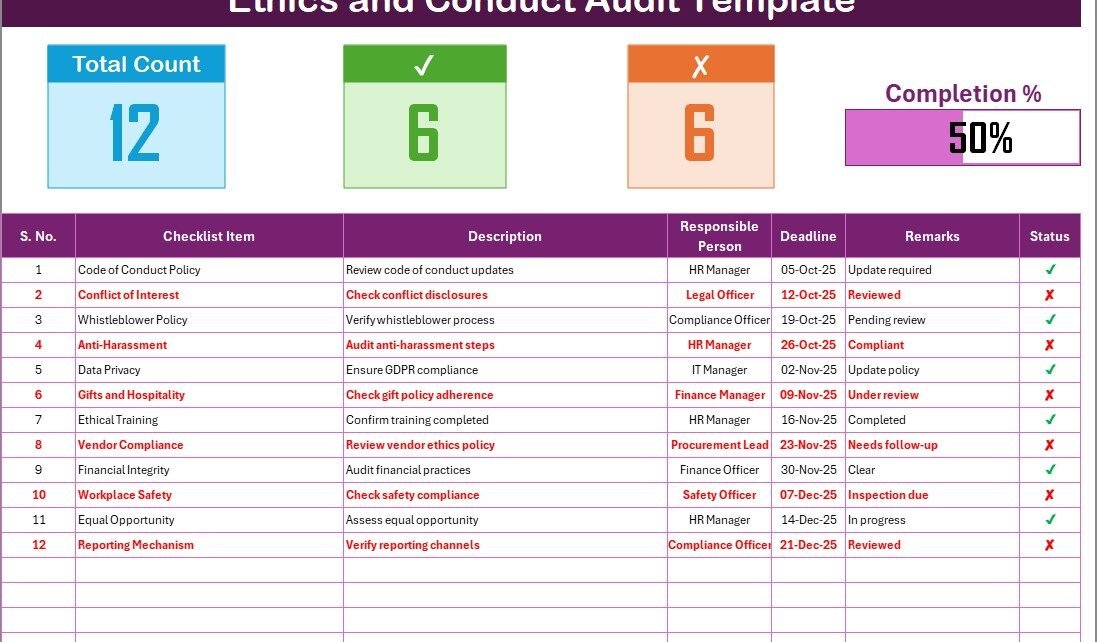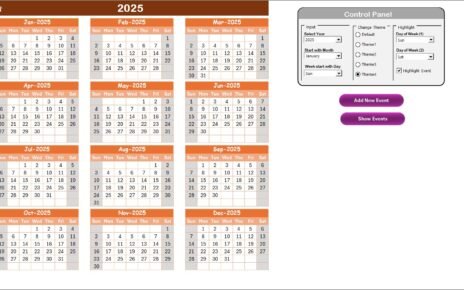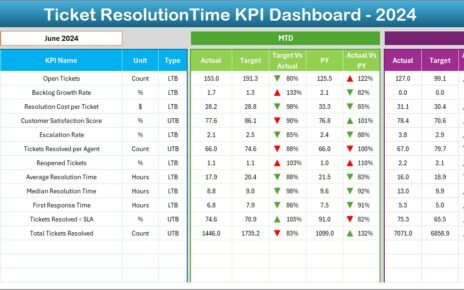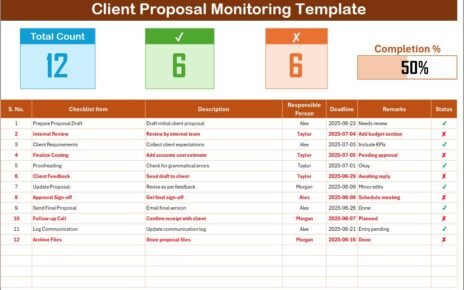In today’s business world, organizations are under constant pressure to maintain ethical standards, foster transparency, and promote fair conduct. A company’s reputation, sustainability, and compliance depend on how well it manages ethical practices across all levels. However, tracking and monitoring ethical conduct can be challenging without a structured system.
This is where the Ethics and Conduct Audit Checklist in Excel becomes an invaluable tool. With this ready-to-use template, businesses can evaluate employee behavior, compliance with company policies, and overall adherence to ethical guidelines. By using Excel, you gain flexibility, customization, and efficiency while ensuring accountability.
In this article, we will explore the structure, features, advantages, best practices, and applications of the Ethics and Conduct Audit Checklist in Excel. Whether you are an HR professional, compliance officer, or team leader, this article will guide you through everything you need to know.
Click to Purchases Ethics and Conduct Audit Checklist in Excel
What Is an Ethics and Conduct Audit Checklist?
An Ethics and Conduct Audit Checklist is a structured framework that helps organizations evaluate compliance with ethical standards and workplace conduct policies. Instead of relying on verbal feedback or unstructured reports, this checklist provides a systematic approach to:
-
Monitor employee behavior.
-
Ensure alignment with corporate values.
-
Identify misconduct early.
-
Strengthen compliance with internal and external guidelines.
By using a checklist format in Excel, organizations can simplify data collection, track progress, and visualize results through counts and progress bars.
Why Use Excel for Ethics and Conduct Audits?
Excel is one of the most widely used tools for auditing, reporting, and compliance tracking. Using Excel for an ethics and conduct audit checklist provides several advantages:
-
Flexibility: Customize columns, add or remove items, and design workflows according to company needs.
-
Automation: Use formulas to calculate totals, percentages, and compliance scores automatically.
-
Visualization: Track progress with progress bars and conditional formatting.
-
Accessibility: Excel files are easy to share across teams and departments.
-
Cost-Effective: No need for expensive compliance software.
By leveraging Excel, companies ensure that the audit process is efficient, transparent, and adaptable.
Structure of the Ethics and Conduct Audit Checklist in Excel
The ready-to-use template comes with two main worksheets:
1. Ethics and Conduct Audit Checklist Sheet
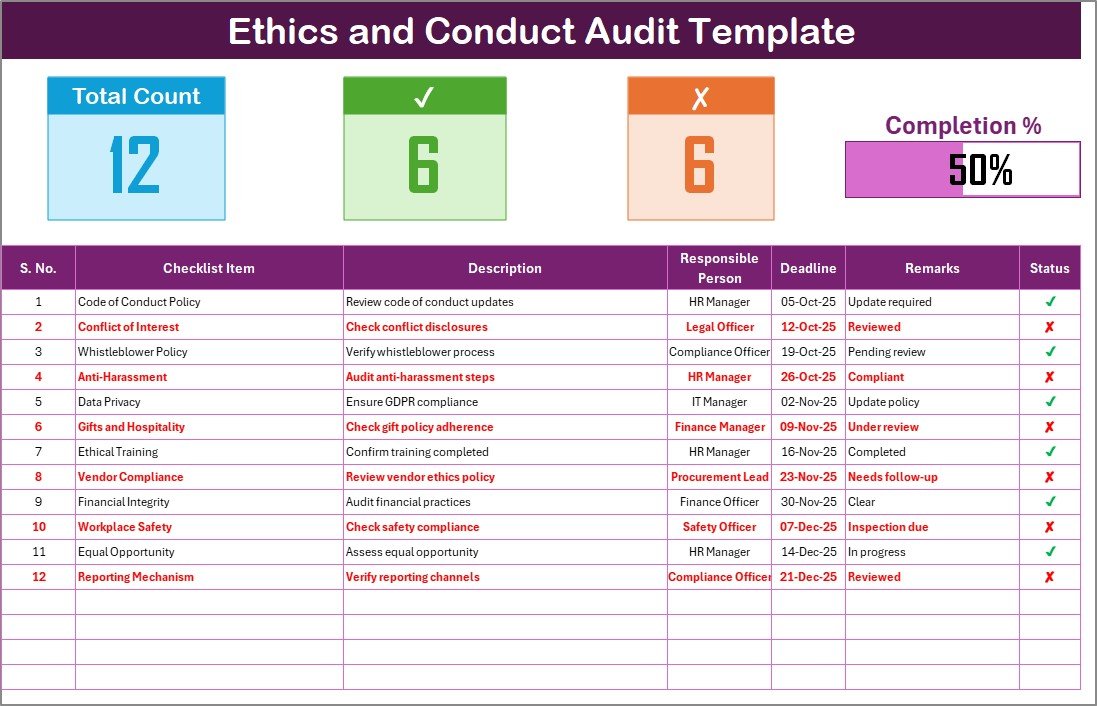
This is the main working sheet where audit tracking takes place.
Top Section
The top section gives a quick summary of the audit:
-
Total Count: Number of checklist items.
-
Checked Count: Number of items marked as completed (✔).
-
Crossed Count: Number of items marked as not compliant (✘).
-
Progress Bar: Visual representation of completion percentage.
Checklist Table
The heart of the sheet is a structured table with the following columns:
-
Serial No. – Automatically numbered for easy tracking.
-
Checklist Item – The specific audit point (e.g., Code of Conduct Training, Whistleblower Policy).
-
Description – A short explanation of the item.
-
Responsible Person – The individual accountable for the task.
-
Deadline – The target date for compliance.
-
Remarks – Additional notes or observations.
-
Status – Marked as ✔ (completed) or ✘ (not done).
This format ensures clarity, accountability, and easy reporting.
2. List Sheet
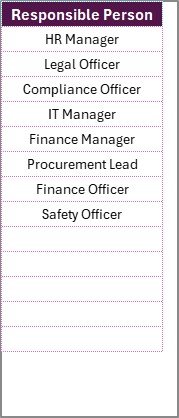
The second sheet stores the unique list of Responsible Persons. This data is used to create drop-down lists in the main checklist table, ensuring consistency and accuracy.
With this structure, organizations can manage responsibilities efficiently and avoid duplication or confusion.
Click to Purchases Ethics and Conduct Audit Checklist in Excel
Key Features of the Template
-
Ready-to-use Excel format.
-
Simple interface with structured fields.
-
Automatic calculation of progress.
-
✔ / ✘ marking system for easy evaluation.
-
Dropdown lists for Responsible Person column.
-
Flexibility to add new items or modify existing ones.
-
Visual progress bar for tracking compliance.
Advantages of Ethics and Conduct Audit Checklist in Excel
An ethics and conduct audit checklist in Excel offers multiple benefits to organizations:
✅ Ensures Accountability: Assign tasks to responsible persons and monitor their completion.
✅ Improves Transparency: Clear records of ethical compliance foster trust across the organization.
✅ Simplifies Reporting: Generate compliance summaries instantly using Excel formulas and charts.
✅ Encourages Consistency: Standardized structure ensures the same criteria apply to all departments.
✅ Strengthens Compliance: Regular audits ensure adherence to company rules and external regulations.
✅ Supports Risk Management: Early detection of misconduct reduces legal and reputational risks.
✅ Enhances Efficiency: Quick tracking with progress bars and automated counts saves time.
How to Use the Ethics and Conduct Audit Checklist in Excel
Using the template is simple and intuitive. Here’s a step-by-step guide:
-
Open the Template
Start with the prebuilt Excel file, which comes with all required fields. -
Customize the Checklist Items
Replace the sample items with your organization’s ethics and conduct points, such as:-
Employee Code of Conduct.
-
Anti-Harassment Policy.
-
Conflict of Interest Disclosure.
-
Data Privacy and Security Measures.
-
-
Assign Responsible Persons
Use the dropdown feature to assign tasks to specific employees or managers. -
Set Deadlines
Add realistic deadlines for each item to ensure timely completion. -
Update Status
Mark ✔ for compliance and ✘ for non-compliance as you review items. -
Review the Progress Bar
Check the overall progress to see how much of the audit is complete.
Best Practices for the Ethics and Conduct Audit
To maximize the effectiveness of the checklist, follow these best practices:
🔹 Keep Items Short and Clear: Avoid long descriptions. Use concise points for easy tracking.
🔹 Update Regularly: Review the checklist at scheduled intervals.
🔹 Engage Stakeholders: Involve HR, compliance teams, and department heads.
🔹 Encourage Reporting: Promote a safe environment for employees to report misconduct.
🔹 Leverage Excel Features: Use filters, conditional formatting, and charts for better insights.
🔹 Archive Old Checklists: Keep past records for reference and compliance audits.
🔹 Link Policies: Add hyperlinks to relevant policy documents within the checklist.
Real-World Applications
Organizations across industries can benefit from this Excel-based checklist:
-
Corporate HR Departments: Track employee training and policy adherence.
-
Compliance Teams: Monitor regulatory and internal compliance.
-
Educational Institutions: Ensure staff and student behavior aligns with codes of conduct.
-
Healthcare Facilities: Track ethical practices related to patient care and safety.
-
Nonprofits: Promote transparency in governance and resource allocation.
Conclusion
An Ethics and Conduct Audit Checklist in Excel is more than just a tool—it is a strategic approach to fostering integrity, transparency, and accountability within an organization. With its structured design, progress tracking, and flexibility, this checklist helps businesses ensure compliance with ethical standards while minimizing risks.
By adopting this Excel-based template, organizations can move from reactive problem-solving to proactive compliance management.
Frequently Asked Questions (FAQs)
1. What is the purpose of an Ethics and Conduct Audit Checklist?
The checklist helps organizations track and evaluate adherence to ethical standards, policies, and conduct guidelines.
2. Why should I use Excel for an ethics and conduct audit?
Excel offers flexibility, automation, and visualization features without the cost of specialized compliance software.
3. Can I customize the checklist items?
Yes. You can add, edit, or remove items based on your organization’s policies and compliance needs.
4. How does the progress bar work?
The progress bar automatically calculates the percentage of items marked as ✔, giving a visual representation of overall compliance.
5. Who should use this checklist?
HR professionals, compliance officers, auditors, team leaders, and managers across industries can benefit from this tool.
6. Can this checklist replace compliance software?
It does not replace advanced compliance software but provides a cost-effective and efficient alternative for small to medium-sized organizations.
7. How often should I update the checklist?
You should update the checklist regularly—monthly, quarterly, or annually—depending on your organization’s compliance cycle.
Visit our YouTube channel to learn step-by-step video tutorials
Click to Purchases Ethics and Conduct Audit Checklist in Excel
Watch the step-by-step video tutorial:
